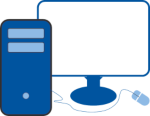This is my third contribution to our little series on life and work as a research assistant. Today I’ll focus on research and want to take you into my area of expertise. Research can be boring, challenging, obvious, exciting, frustrating and incomprehensible, sometimes all at the same time.
Sometimes, I’m a dreamer. And I’m a teacher. And a nerd. So naturally, I daydream the classroom of the future. While interactive whiteboards have, as no one would have expected ten years ago, found their way into an astonishingly high number of classrooms in Germany’s higher education institutions, most are used for one of two purposes: Either they are just projection units or maybe even used as some kind of fancy replacement for an actual whiteboard (with – honestly – less features). The causes for that are manifold, but boiling it down to the main ones, there are two remaining: Lack of advanced training for teachers and missing open content.
Well, those devices are there now, but I wouldn’t even think of putting those into the center of my research ambitions as I see major disadvantages in that technology. Some of the smaller ones might be overcome, as the persistent need for calibration, while the big ones are not done with better firmware or whatever: First, they just hang on the wall. No really feasible possibility to put those monsters in the center of a classroom without making them the one and only center of attention. Second, those devices are, deep in the fundamentals of the technology put to use, single touch. If you have access to such a device, just try it. Take one pen in one hand, one in the other and try to draw two lines simultaneously. Have fun. Single touch means head-on instruction. The teacher in focus. No deep down modern constructivism, no cooperation, no collaboration. Breaking my heart.
But there are silver linings far up the horizon: Multi-touch capable devices, both wall-mounted, table-top or even convertible are on the rise and getting more and more affordable. MS went ahead an threw their surface hub 84″ on the market: incredible, amazing, beautiful devices. Bulky, heavy, expensive and always upright. Didn’t hinder us to convert it to tabletop. And that’s where I work on. A large 84″ interactive 4k tabletop display.
While those technology does not seem compatible with either the current infrastructure of today’s classrooms or the budget of public schools, it keeps advancing. There are actually fully convertible 65″ 4K devices with 50 simultaneous touch points for a third of the price available right now, not even two years after the surface hub hit the market.
Why am I telling you all that stuff about potential classroom hardware? Because I want the classroom of the future to be a real success! Multi-touch tabletop displays have the potential to lift cooperative group work to a new level, but this will only work if there is a) content and b) supportive technologies.
The former is a problem too massive to tackle alone. One person, one dissertation can’t even dream about developing content for all possible topics or even subjects. But some content will be there as a by-product of my dissertation, more important a framework simplifying the development of content.
But the latter is the topic which keeps me going. We already know a lot about group situations in classroom environments. We also know a lot about learners behavior in technology enhanced learning like traditional e-learning. But we don’t know much about the combination of those two. E-Learning offers possibilities like automated (informative) feedback. But how does a group of four react to feedback of a single system? Is the little introvert interacting with the display in his little corner that intimidated by a negative feedback that he stops interacting at all? Is he to shy to reach all over the screen to grab the element he needs to solve his task?
My goal is to to research on this kind of interaction to understand the learners behavior based on individual traits and provide automated adaptive feedback as well as mechanisms and guidelines to developers to enhance their applications to offer an optimized learning experience to all their learners.
